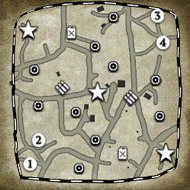This post strongly reaffirms what I was saying in another post.
COH2 needs a way to have more maps that are not player vs player oriented. It needs some sort of Custom games automatch. Where the scores do not count but it lets players play more "FUN" oriented maps. There are a lot of players that just want to relax and make giant armies and watch stuff blow up.
The point of Customs Games is that players can set up their own matches with each other, and against each other. The various rooms exist for that purpose. I think if you extend that to wanting automatched matches, i.e. between AT teams and random teams, then it should stay in automatch.
FACTS:
1) There is no way to learn this game from within the game. Cover, Weapons, RNG, garrisons etc are not covered anywhere in the game.
2) Maps are too open to learn from playing AI bots that flank you all the time.
3) Maps are too big and open for head-on meat grinder matches against people. Except Redball and Port of Hamburg 
That may be a little harsh? Relic deliberately set out to design COH2 to be more user-friendly for the casual player and therefore by definition, less e-sports oriented. e.g. the 'come-back' mechanic
As I said before Helping Hans was a casual at one point. Now he is one of the best players. How many other players has COH2 lost due to the steep undocumented learning curve. MGs and mortar do not need a manual to use. They let people get their feet wet and gradually learn while having fun.
In fairness to Hans, he was never casual in COH1 or COH2. He may have had to endure the steep learning curve as a new player from Dawn of War, but that was for him in COH1. I watched Imperial Dane nurture Hans in Dane's early casts, when he also brought on players like Andy is Rippin; I watched Hans practising to join the Reborn. Hans was never casual, but it took him until last year (2016) to ascend the peaks. And fair dos to Hans for keeping on with it. But it does take determination.
Now, onto your other point: COH RTS has always been a steep learning curve.
Relic tried to ameliorate that in COH 2 with the 'come=back' mechanic. I think it was wrong, but that is only my opinion. Relic set out in their tutorials to make COH2 easier to grasp.
Having said that, I think it takes a new player who is unfamiliar with COH RTS to require at least 100 hours in-game in automatch, in order to become reasonably proficient. And I don't see how you can really reduce that time below 100 hrs. To get acquainted with retreating = squad preservation, or to understand that cover means a lot, and to learn the various commanders and their abilities, as well as the maps: it is arguable that the sheer choice in COH2 makes it as hard to master as COH1.
The problem is that the average player only spends 10 hrs, if that, on a game. That is the bleed which I suspect limits RTS as a popular game and makes it impossible for Relic to break through the glass ceiling, in order to provide a game attractive to a mass audience.
StarCraft was clicks per minute on simple maps, sponsored by South Korea. Relic has always wanted asymetrical maps and asymetrical armies, which is part of its attraction for RTS players. COH2 was more micro orientated (CPM), but although Vancouver was prepared to sponsor the games industry and subsidise Relic, it did not have the single mindedness of South Korea to push the game onto a worldwide stage, and Relic did not compromise on its ambition in COH2 to reach out for the casual user. viz the OP Commanders like Tiger Ace. Arguably, ultimately, both sides competing within Relic lost out: CoH2 could not be an e-sport and neither could/did it satisfy the ultimate casual user, who wanted an easy game to learn.



 14
14![]()
![]()

 United Kingdom
United Kingdom United Kingdom
United Kingdom cblanco ★
cblanco ★  보드카 중대
보드카 중대  VonManteuffel
VonManteuffel  Heartless Jäger
Heartless Jäger 